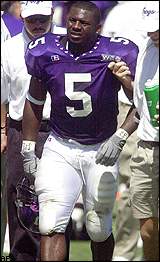 |

|
Friday, November 3
Overtime system needs overhaul
By Mel Kiper
ESPN.com
As we enter the first Saturday of autumn, it's safe to say summer went out with a bang. While the state of Florida was dealing with Hurricane Gordon, college football fans enjoyed yet another great day of riveting action and unbelievable finishes.
All of the marquee matchups went down to the wire, while a number of other less-publicized contests provided an equal amount of drama and excitement.
|  | | Northwestern vowed to shut down tailback LaDaimian Tomlinson, but the Heisman candidate racked up 243 yards rushing in TCU's romp. |
Let's begin at South Bend where Notre Dame pulled off a minor upset over Heisman Trophy candidate Drew Brees and the Purdue Boilermakers. As was the case the previous week in their overtime loss to Nebraska, the Irish showed that special teams mean as much to a football team's success as offense and defense.
Keying the Irish's nail-biting 23-21 victory was a blocked punt that set up a TD as well as a botched fake punt by Purdue deep in its own territory. They also changed the scoreboard when CB Shane Walton picked off a Drew Brees aerial and raced 60 yards for a TD. Sophomore QB Gary Godsey led the Irish on their final drive which culminated in Nick Setta's game-winning 38-yard field goal as time ran out.
This again proves my point as to why the current overtime system in college football is extremely flawed. Against Nebraska, a 100-yard kickoff return by Julius Jones for a TD, along with an 83-yard punt return Joey Getherall took all the way to paydirt, could never occur during an overtime session in college football. Nor could a blocked punt or the benefits of successfully dealing with a fake punt by Purdue be part of the equation in overtime.
To win a football game, you have to be sound in all three phases of the game. In overtime, outside of field-goal attempts, special teams is eliminated from the process. In my opinion, that's not the way to allow a hard-fought college football game to be decided.
What is the best way to close things out? First of all, there is nothing wrong with a tie. Some of the greatest, most memorable and most discussed games from the past ended in a tie.
If overtime is a must, the best way I see to determine a winner is the NFL system. I guess that's where the problem lies. For whatever reason, I've been told time and again by observers of college football that doing things the exact same way as the NFL isn't necessarily an option they see being implemented.
Why not? Sure, the NFL's system may not be perfect. It doesn't guarantee both offenses will touch the football. It also extends the action to potentially an entire quarter, without assurance that a winner will be determined. Those who oppose the NFL's system argue that extending the game would lead to the possibility of injuries arising due to fatigue.
In my opinion, the current system places just as much wear and tear on the players -- and maybe even more. By placing the ball at the 25-yard line going in, defensive packages are more limited than would be the case in the normal flow of a game. Each team is basically defending their goal line on every snap.
If you are concerned about the length of games, keep the clock running on a first down while the chains are being moved. In conclusion, any overtime system that basically eliminates special-teams play is not the right way to determine the outcome of a game.
Now back to some thoughts from this past weekend. Let's start with the Tennessee-Florida game at Neyland Stadium in Knoxville. The Vols controlled the line of scrimmage, providing an opportunity early to open up a sizeable lead on the Gators. Instead, they had to settle for field goals, allowing Florida to remain within striking distance.
Despite a tremendous effort by RB Travis Henry (37 carries for 175 yards and also the first Volunteer RB to rush for over 100 yards against the Gators since 1990), the Vols couldn't deliver the knockout punch. Trailing 23-20, senior QB Jesse Palmer engineered a 91-yard scoring drive which ended with a controversial three-yard TD pass to Jabar Gaffney with just seconds remaining. You could debate whether the pass should have been ruled incomplete, but the missed opportunities for TDs by the Vols spelled their demise.
|
“ |
As far as the Heisman Trophy is concerned, Virginia Tech QB Michael Vick showed once again versus Rutgers that he is a special performer with the overall skill level future Hall of Famer Steve Young displayed while he was at BYU. ” |
At the Rose Bowl, UCLA put together a strong second half, handing the Michigan Wolverines their first loss of the season. After two excellent performances against weak competition (Bowling Green and Rice), redshirt freshman QB John Navarre struggled versus the improved Bruin defense, completing just 8 of 28 passes. This basically eliminates any talk of a potential QB controversy once junior signal-caller Drew Henson comes off the injury list.
In a game I thought would end with a Colorado victory, the Washington Huskies remained unbeaten, coming away with a hard-fought 17-14 win over the Buffaloes. Again credit QB Marques Tuiasosopo. Despite a less-than-spectacular overall performance, when the veteran senior needed to make a play, he delivered.
Another key to the Huskies' early success has been the dominating play of junior DT Larry Tripplett. The talented 6-foot-1, 293 pounder has been a disruptive force up front, ending plays in the backfield before they even had a chance to get started.
After a welcome week off this Saturday, Rick Neuheisel's squad faces a tough road challenge against the Oregon Ducks on Sept. 30. Also circle the date Nov. 11. That's when they'll host UCLA. Keep in mind, the Huskies don't play USC, and if the two teams end in a tie for the conference lead, Washington goes to the Rose Bowl.
Then we saw Florida State finally generate an effective running game. Travis Minor picked up 112 yards against North Carolina, while senior wide-out Snoop Minnis came through with a highlight-film reception.
Staying in the ACC, if Florida State has a challenger, it's obviously Clemson. The two teams don't meet until Nov. 4 at Doak Campbell Stadium in Tallahassee. The Tigers destroyed Wake Forest 55-7 this past week, paced by multi-dimensional signal caller Woodrow Dantzler and their outstanding LB Keith Adams.
As far as the Heisman Trophy is concerned, Virginia Tech QB Michael Vick showed once again versus Rutgers that he is a special performer with the overall skill level future Hall of Famer Steve Young displayed while he was at BYU.
If TCU runs the table, as is possible, RB LaDainian Tomlinson has to be at or near the top of the list if he continues to run wild. Against Northwestern on Saturday, the dynamic 5-foot-10, 220 pounder carried the ball 39 times for 243 yards, scoring 2 TDs. That total would have been around 350 had it not been for a pair of TD runs (74 and 34 yards) being called back because of penalties. Don't be surprised if Tomlinson ends up being one of the top five players selected in the NFL Draft this coming April.
How about the Pac-10? Not only have they silenced the critics, but Washington, UCLA and Stanford have seriously damaged or destroyed the national championship hopes of Miami (Fla.), Michigan, Texas and Alabama.
In the SEC, Lou Holtz actually has South Carolina tied for the lead in the East with Florida. After going 0-11 last season, Holtz and the Gamecocks are 3-0 so far, with key games on the horizon against Mississippi State (this Saturday) and Alabama. In sophomore RB Derek Watson, Holtz has one of the elite young running backs in college football.
Conversely, Alabama currently has the second worst overall record (1-2) in the SEC, behind only Vanderbilt. In their home shutout loss to Southern Mississippi on Saturday, heralded junior wide-out Freddie Milons hauled in 7 receptions but also dropped a few catchable passes.
Wisconsin has overcome a key injury to talented senior WR Chris Chambers as well as all the suspensions to remain unbeaten, despite three hard-fought contests against Western Michigan, Oregon and Cincinnati that could have gone either way.
While Iowa and Northwestern were expected to struggle for victories, joining Penn State as a major disappointment so far has to be Indiana. With high expectations coming in, due to the presence of their gifted junior signal-caller Antwaan Randle El, the Hoosiers have blown double-digit leads in each of their first two games which ended in gut-wrenching losses to N.C. State and Kentucky. As was the case last year, Indiana's defense has been its Achilles heel.
And finally, on the injury front, X-rays were negative on Ole Miss RB Deuce McAllister's sprained right shoulder and his practice status is currently listed as day-to-day. The Rebels' open date couldn't have come at a better time. They are off this week, allowing McAllister the necessary time to work his way back to 100 percent in preparation for their battle with Kentucky on Sept. 30.
Later in the week I will update the injury status of the other noteworthy performers in college football, such as Illini QB Kurt Kittner, who left the game against California on Saturday with a sprained knee.
|
|


